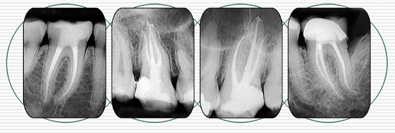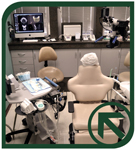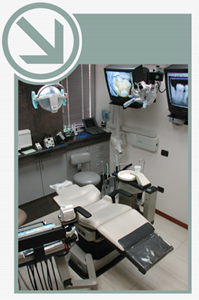![]()
![]()
![]()
![]()
![]()

 |
 |
Welcome. The purpose of this page is to include general information that answers the most frequently asked questions by those patients who are interested in our specialty. Surely you have heard sometime that a tooth needs a "root canal treatment". Many people fear this treatment because they are not properly informed about it. Our goal is to provide the best possible treatment according to the newest cientific knoweledge and advances in technology, techniques and materials.
- What is endodontics?
- Why does the dental pulp become ill?
- What is an endodontic treatment (root canal treatment)?
- How long does it take to perform a root canal treatment?
- Is this treatment painfull?
- What can you expect after treatment?
- Are there other types of endodontic treatments?
- Re-treating previous root canal treatments
- Periapical surgery
- New technologies in endodontics
- Are you looking for information in other areas of dentistry? Visit our Dental column
![]() What
is endodontics?
What
is endodontics?
Endodontics refers to the interior (Endo) of the teeth (Dontia). Thedental pulp is the tissue located inside the teeth and it is composed of nerves, blood vessels and specialized cells; among others. It's main function is to form the teeth (during the formation period of these structures) and secondly to perceive external stimuli. Endodontics is the dental specialty dedicated to prevent, diagnose and treat the illnesses of the dental pulp and the tissues that surround it.
![]() Why
does the dental pulp become ill?
Why
does the dental pulp become ill?
The most frequent reasons for the dental pulp to become ill are:
- Dental caries (deep cavities).
- The cumulative effect of numerous dental procedures performed on a tooth.
- Traumatic injuries (accidents).
On the other hand, the conditions under which a tooth might need a root canal for the first time can be divided in two big groups:
- When there is an irreversible inflammation in the dental pulp (called pulpitis).
When there is necrosis of the dental pulp (the pulp dies).
![]() What
is a root canal treatment?
What
is a root canal treatment?
The treatment of choice for the inflammatory conditions and necrosis of the dental pulp is basically the same, a root canal treatment. This form of therapy consists in completely removing the pulpal nervous tissues and other contents (in the case of infections or necrosis) from inside the roots. Afterwards, the remaining spaces are disinfected and filled with an inert material. The purpose of this treatment is to create a clean environment inside the roots so the inflammation subsides and the surrounding tissues can heal so the tooth can function normally without any symptoms.
![]() What
about after treatment?
What
about after treatment?
In most cases after the procedure is completed, you can expect mild discomfort. In other less frequent occasions there might be some more discomfort. But the truth is that in the majority of cases you will not feel anything at all. If you feel anything this can be very easily treated for a few days with an over the counter analgesic.
![]() Re-treating
previous root canal treatments (Root canal
retreatment)
Re-treating
previous root canal treatments (Root canal
retreatment)
This is always the first choice when a previous root canal treatment has failed. The treatment consists in removing the material inside the canals, a thorough cleaning and disinfecting process along (if possible) with the identification of the reason(s) for the failure. The canals are then re-sealed again.
In many of the cases, the cause of the previous failure is corrected (e.g. some canals were not treated or were treated incompletely). In this way, surgery can be avoided. On the other hand, it may also happen that lesions do not heal after this so the case has to be resolved using surgery. If this is the case, it is always advisable to get to this stage with the best possible root canal treatment, as this will enhance the results of the surgical procedure.
![]() Periapical
surgery
Periapical
surgery
Periapical surgery is the treatment of choice when everything else has failed or in those cases where a re-treatment is not feasible (e.g. when canals are not accessible due to obstructions, unremovable cemented posts, etc)
Instead of approaching the problem through the tooth, this type of surgery approaches the root tip directly entering from the gum and bone. During the procedure, the tip of the root is identified eliminating a very small piece of it (the last 3 millimeters) together with the lesion. This procedure is called "apicectomy". Afterwards, a small hole is prepared in the tip of the root, which is then sealed with a material that precludes the microfiltration of contaminant elements from the tooth to the surrounding supporting tissues. More information about this procedure can be found in the web site of the American Association of Endodontics.
![]() New
technologies in endodontics
New
technologies in endodontics
The practice of endodontics has dramatically changed in the past decade. This is directly related to the development of new equipment and new designs in the instruments. In this same manner, dental professionals dedicate extensive hours to continuing education in this field and some of them even undertake specialty courses lasting a couple of years becoming certified "specialists in endodontics". Some of the recent advances in endodontics are:
- Computerized radiographs: These new types of radiographs are taken with a special sensing device that substitutes the x-ray film. Images can be viewed immediately in the computer screen without the need for development of the film. The real advantage for the patient is the reduction of the levels of radiation because for this new type of image only 1/8 of the usual radiation is needed.
- Nickel-titanium instruments: The files are instruments that are used for cleaning and shaping the root canals. Until recently, these instruments had limited flexibility because they were made out of stainless steel. Many of them fractured inside the tooth during its use. Nickel-titanium is a material that is 450 times more flexible than stainless steel and permits easy preparation of even the most curved root canals.
- Rotary (Mechanical) instrumentation: The use of dental files adapted to rotatory instruments is a breakthrough and it is possible because of the added flexibility of the new types of files. This technique makes it easier and faster to clean and shape the root canals before sealing them.
- Electronic apical-foramen (apex) locators: This technology permits the rapid electronic determination of the exact place where the root canal ends inside the root tip. In the past, this was done by radiograph observation and visual approximation. Several radiographs needed to be taken and the procedure was inexact and took a longer time.
- Ultrasonic equipment: They allow the controlled vibration of certain instruments that clean and shape the root canals. They also help in the removal of obstructions and objects (e.g. cemented posts) from the roots. This type of equipment has even revolutionized the way of preparing the root tips during the apicectomy procedures in Periapical surgery, making it a very reliable technique with excellent results.
- Clinical microscopes: Because the working area in endodontics is so small (a root canal can have one millimeter in diameter) magnification of the viewing field is very important. For these reasons different types of loupes, telescopic loupes and lately microscopes have been developed. Although many cases can be solved without these magnifying aids, they are extremely helpful because the human eye has important limitations when these types of treatments are performed. This is especially true when re-treating canals or during periapical surgeries.
 |
Everything has to be performed under strict disinfecting and sterilization. Many of the materials that are used are disposable and many of those that are re-usable are sterilized and disinfected and afterwards are protected with disposable protective shields.
 |
http://www.ceo.com.ve |
 |
If you have any question please e-mail us at carlosboveda@carlosboveda.com , or feel free to contac-us through our guest book.


